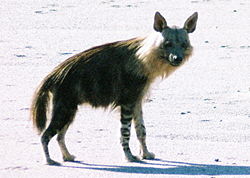Brown hyena
| The metadata subpage is missing. You can start it via filling in this form or by following the instructions that come up after clicking on the [show] link to the right. | |||
|---|---|---|---|
|
| brown hyena | ||||||||||||||||
|---|---|---|---|---|---|---|---|---|---|---|---|---|---|---|---|---|
 Brown hyena (Parahyaena brunnea), Namibia.Template:Photo
| ||||||||||||||||
| Conservation status | ||||||||||||||||
| Scientific classification | ||||||||||||||||
| ||||||||||||||||
| Binomial name | ||||||||||||||||
| Parahyaena brunnea Thunberg, 1820 |
The brown hyena Parahyaena brunnea is the only species within the genus Parahyaena. It has the most restricted range of the members of the family Hyaenidae. Current research is showing that the behaviour of this hyena is extremely variable.
Diet
Not an efficient hunter, in most of its range the brown hyena is primarily a scavenger and forages a wide range of food from vegetables and fruit to reptiles, birds and mammals. The lone exception to this is the populations living on the Namibian coast where they have been observed killing seal pups. They are capable of scavenging from the largest available prey in the region [2] They are known to collect vast quantities of faunal remains in their dens, said collections of bone are a direct reflection of the other species found in the region at the time of collection [2].
Geographical distribution
The range of brown hyena is limited to areas of Namibia, Botswana, South Africa, Zimbabwe and south west Angola. At one time their range extended all the way to Table Bay in the Western Cape of South Africa [3].

